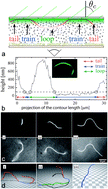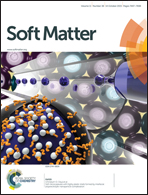Abstract
Polymer adsorption is a fundamental problem in statistical mechanics that has direct relevance to diverse disciplines ranging from biological lubrication to stability of colloidal suspensions. We combine experiments with computer simulations to investigate depletion induced adsorption of semi-flexible polymers onto a hard-wall. Three dimensional filament configurations of partially adsorbed F-actin polymers are visualized with total internal reflection fluorescence microscopy. This information is used to determine the location of the adsorption/desorption transition and extract the statistics of trains, tails and loops of partially adsorbed filament configurations. In contrast to long flexible filaments which primarily desorb by the formation of loops, the desorption of stiff, finite-sized filaments is largely driven by fluctuating filament tails. Simulations quantitatively reproduce our experimental data and allow us to extract universal laws that explain scaling of the adsorption–desorption transition with relevant microscopic parameters. Our results demonstrate how the adhesion strength, filament stiffness, length, as well as the configurational space accessible to the desorbed filament can be used to design the characteristics of filament adsorption and thus engineer properties of composite biopolymeric materials.


 Please wait while we load your content...
Please wait while we load your content...